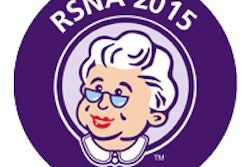
Now that CT lung cancer screening guidelines are formally in place, will clinicians actually advise eligible patients to get screened? The answer is yes and no, according to a survey of pulmonologists published online September 14 in the Annals of the American Thoracic Society.
Researchers from Boston University and various U.S. Veterans Affairs (VA) centers surveyed nearly 300 lung physicians nationwide to assess their views on lung cancer screening with low-dose CT (LDCT). Slightly more than half recommended CT screening for individuals who were eligible, while a more screening-averse minority recommended against screening even for eligible patients.
What's more, nearly one-fourth recommended screening for patients outside of established eligibility criteria.
"Pulmonologists have varied perceptions of the evidence and trade-offs of LDCT screening, leading to potential for over- and underscreening," wrote Dr. Jonathan Iaccarino; Jack Clark, PhD; Dr. Renda Soylemez Wiener; and colleagues (Ann Am Thorac Soc, September 14, 2015).
Gearing up for screening
Nearly a year after the U.S. Centers for Medicare and Medicaid Services (CMS) approved reimbursement for low-dose CT lung cancer screening, institutions are gearing up to provide the service to eligible long-term smokers.
Pulmonologists are key players in setting up lung cancer screening programs, due to the complexity of the process. It will be imperative for them to be aware of which patients are most likely to benefit from screening, the authors wrote.
The study, performed at facilities in the VA network across the U.S., aimed to assess the propensity of pulmonologists to offer lung cancer screening, in addition to their perceptions about LDCT screening and its benefits and harms.
The authors created a 33-question Web-based survey and sent it between July 2013 and February 2014 to all active staff pulmonologists at Veterans Health Administration pulmonary clinics in the 50 U.S. states and Puerto Rico.
The study's primary outcome was the pulmonologists' propensity to order screening scans based on responses to clinical vignettes in relation to the guidelines, the authors wrote. Among 574 eligible pulmonologists emailed, 286 (49.8%) participated in the study.
The survey was designed to assess three domains from the Promoting Action on Research Implementation in Health Services framework: acceptance of evidence, preparedness and receptivity of the local context, and barriers to implementation.
For example, one of the clinical vignettes described a patient eligible for screening based on clinical guidelines, while a second focused on a patient who fell outside the guidelines -- such as someone who had smoked for fewer than 30 pack-years.
The respondents were divided into three groups based their responses to the series of clinical vignettes:
- Overscreeners: Participants who answered "definitely yes" or "probably yes" when asked if they would recommend screening for a patient who wasn't eligible
- Guideline-concordant screeners: Participants who answered "definitely yes" or "probably yes" for the screening-eligible patient and "definitely no" or "probably no" for the screening-ineligible patient
- Underscreeners: Those who answered "definitely no" or "probably no" regarding screening, whether the patient was eligible or not
The researchers then measured how perceptions of the evidence for and against screening, the trade-offs, and barriers to implementation affected the physicians' propensity to screen.
Most followed guidelines
Just over half of the respondents (52.4%) had a propensity for appropriate lung-cancer screening, Iaccarino and colleagues found. A total of 22.7% had a propensity for overscreening, and 24.9% had a propensity for underscreening.
When responding to the patient vignettes, 74.2% said they would offer screening to guideline-eligible patients, 24.5% said they would offer screening to guideline-ineligible patients, and 50.4% said they would offer screening to guideline-marginal patients.
Most respondents were familiar with lung cancer screening guidelines from the National Lung Screening Trial (NLST) and other sources, were comfortable managing patients with pulmonary nodules and lung cancer, and did not have a lung cancer screening program in place at their site.
The underscreeners category included a higher proportion of men and those with more years in clinical practice. They had less familiarity with the NLST guidelines and would have referred patients less frequently for lung cancer screening.
Influential factors that affected the decision of pulmonologists to screen were reduced mortality, clinical trial evidence, and LDCT screening guidelines, among those with a propensity to overscreen or screen appropriately, the group wrote.
Underscreeners were less likely to be influenced by trial evidence and guidelines but more likely to be influenced by the potential harms of screening, compared with the guideline-concordant group. Conversely, none of the variables were significantly associated with a propensity to overscreen versus screen appropriately, the authors noted.
Most respondents believed that the evidence for CT screening is strong (61.5% agreed, 15.9% strongly agreed), and that LDCT screening is likely to be effective at the VA (53.1% agreed, 18.6% strongly agreed). Still, those with a propensity for underscreening were less likely to agree with those views.
Important implications
Overscreening and underscreening both have important implications for outcomes, the group noted. Screening lower-risk patients offers fewer benefits but equivalent potential harm, including a substantial risk of identifying additional findings that need follow-up. The follow-up process entails complication rates from biopsy, as well as increased anxiety, emotional distress, and financial costs.
On the other hand, underscreening carries the risk of missed opportunities for a lifesaving intervention among individuals at high risk of lung cancer.
The most important perceived barriers to LDCT screening were high cost, insufficient infrastructure, and insufficient staff.
"This suggests that the surveyed pulmonologists believe contextual limitations are the most significant barriers to implementation as opposed to limitations at the patient or physician level," the authors wrote. "This is of particular importance given the contextual components that have been identified as essential for high-quality lung cancer screening programs."
Among the study's limitations, performing the survey at VA medical centers may limit the generalizability of the results, they wrote.
"Overall, while most pulmonologists in our survey reported familiarity with the NLST and LDCT screening guidelines, there are significant differences in their interpretation of the balance of benefit to harm, resulting in the potential for both overscreening and underscreening," Iaccarino and colleagues concluded.
It is critical that physicians recognize which patients may appropriately be screened and which may not to improve the shared decision-making discussion regarding the trade-offs of screening, they added.




















